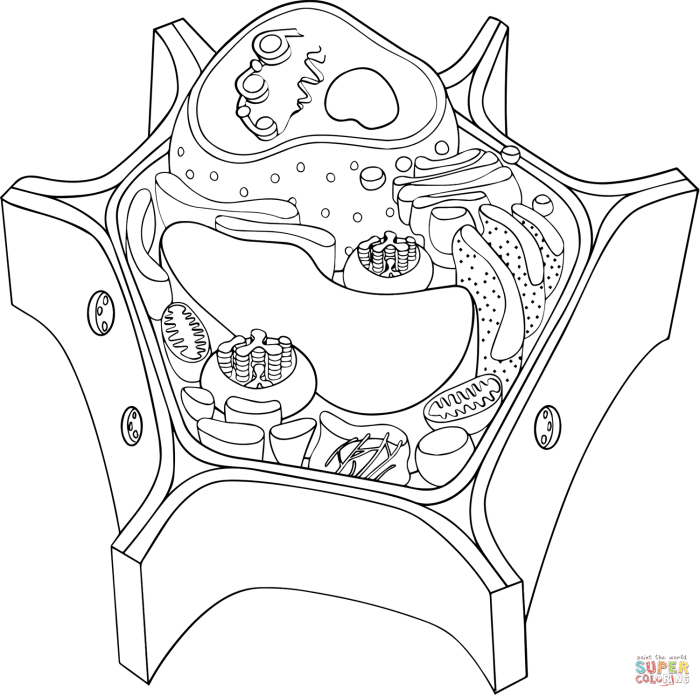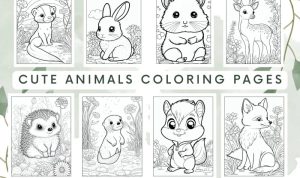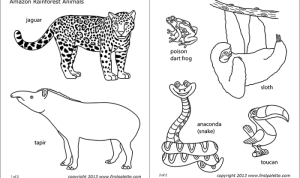Visual Differences

Animal vs plant cell coloring page – Understanding the visual distinctions between animal and plant cells is crucial for accurately representing them in a coloring page. While both are eukaryotic cells sharing some common organelles, key structural differences are readily apparent and provide excellent opportunities for creative representation. These differences primarily stem from the varying functions and lifestyles of these cell types.
Let’s explore the key visual differences you’ll want to highlight in your coloring page.
Cell Structure Comparison
The following bullet points detail the significant structural differences between animal and plant cells, focusing on aspects easily visualized in a coloring activity.
- Cell Wall: Plant cells possess a rigid outer cell wall, providing structural support and protection. This should be depicted as a thick, solid line surrounding the cell membrane in your coloring page. Animal cells lack a cell wall, resulting in a more flexible and irregular cell shape.
- Chloroplasts: Plant cells contain chloroplasts, the sites of photosynthesis. These organelles are usually depicted as oval-shaped structures containing stacks of thylakoids, which can be represented as smaller, interconnected circles within the larger oval. Animal cells lack chloroplasts and thus this feature is absent from their visual representation.
- Vacuoles: Plant cells typically have a large, central vacuole that occupies a significant portion of the cell’s volume. This should be drawn as a large, empty space within the cell, often pushing other organelles to the periphery. Animal cells may have smaller, numerous vacuoles, or they may lack vacuoles altogether. The difference in size and number is key to visually distinguishing the two.
Understanding the differences between animal and plant cells is often easier with a visual aid like an animal vs plant cell coloring page. For a broader approach to cell structure and animal anatomy, you might also enjoy exploring the diverse range of illustrations found in animal coloring books pdf. These resources can complement your cell study by providing a wider context for animal life.
Returning to the cell coloring page, remember to highlight the key differences like the cell wall and chloroplasts.
- Cell Shape: Due to the presence of the cell wall, plant cells generally exhibit a more regular, geometric shape (often rectangular or polygonal). Animal cells, lacking the rigid cell wall, tend to display more irregular, rounded shapes.
Organelle Comparison Table
This table summarizes the presence or absence of key organelles in animal and plant cells, further emphasizing the visual differences.
| Organelle | Animal Cell | Plant Cell |
|---|---|---|
| Cell Wall | Absent | Present |
| Chloroplasts | Absent | Present |
| Large Central Vacuole | Absent or small | Present (large) |
| Cell Membrane | Present | Present |
| Nucleus | Present | Present |
| Mitochondria | Present | Present |
Cell Wall Representation
The cell wall is a defining visual characteristic of plant cells. In a coloring page, it should be depicted as a thick, clearly defined outer boundary surrounding the cell membrane. This rigid structure gives plant cells their characteristic shape and is essential for their structural integrity. The absence of this rigid outer layer in animal cells contributes to their more flexible and irregular shapes, which should be reflected in your drawings.
The contrast between the rigid, clearly defined plant cell wall and the absence of such a structure in the animal cell is a crucial visual cue in distinguishing these two cell types.
Coloring Page Design Elements

This section details the design elements crucial for creating a visually appealing and informative coloring page that effectively highlights the differences between animal and plant cells. The design should be simple enough for children to understand and color, yet detailed enough to accurately represent the key structural differences between these two cell types. We will explore color palettes, layout, and labeling strategies to achieve this goal.A successful coloring page will utilize color and shape to emphasize the unique features of each cell type.
Clear visual distinctions will make it easy for the user to identify and differentiate between the various organelles present in both animal and plant cells. Furthermore, a well-designed layout will facilitate direct comparison, enhancing the educational value of the activity.
Color Palette Suggestions, Animal vs plant cell coloring page
Choosing appropriate colors is essential for creating a visually engaging and informative coloring page. The color scheme should not only be aesthetically pleasing but also help to distinguish between different organelles and the overall cell types. Here are some effective color palette examples:
- Animal Cell: A light beige or pale yellow for the cytoplasm, a vibrant pink for the nucleus, a light blue for the ribosomes, and a darker blue for the mitochondria. The Golgi apparatus could be a light green, and lysosomes a dark purple.
- Plant Cell: A light green for the cytoplasm (to represent chlorophyll), a darker green for the chloroplasts, a light brown for the cell wall, a bright yellow for the large central vacuole, and the same colors as the animal cell for the shared organelles. This allows for easy comparison while maintaining visual distinction.
- Alternative Palette: For a more vibrant look, consider using warmer tones for the animal cell (e.g., oranges and reds for organelles) and cooler tones for the plant cell (e.g., blues and greens).
These color choices are suggestions; the ultimate selection will depend on personal preference and the overall aesthetic desired. The key is to ensure sufficient contrast between organelles and between the two cell types for clear differentiation.
Layout and Organelle Labeling
The coloring page should feature a side-by-side comparison of an animal cell and a plant cell. This allows for immediate visual comparison of their structures. Each cell should be clearly labeled with its name. Key organelles should be individually labeled, using simple, clear, and concise text. A simple, yet effective, layout could involve two large, clearly defined circles (representing the cell membranes) placed side-by-side.
Within each circle, the organelles would be represented as simpler shapes (circles, ovals, rectangles) to make coloring easier. The labels for the organelles (nucleus, mitochondria, chloroplast, cell wall, vacuole, etc.) should be placed neatly outside of the cell drawings, with lines connecting them to their corresponding structures. This approach ensures clarity and avoids cluttering the cell diagrams.
The size of the organelles could also reflect their relative sizes within the cells, providing additional educational value.
Educational Applications

A coloring page depicting the differences between animal and plant cells can serve as a valuable and engaging learning tool for children, transforming a potentially dry subject into a fun and memorable experience. By actively participating in coloring the cells and their components, children develop a stronger visual understanding of cell structures and their relative sizes and locations within the cell.
This hands-on approach enhances knowledge retention compared to passively reading about cells from a textbook.This coloring page activity can effectively reinforce key concepts taught in a broader cell biology lesson. The visual representation allows children to connect abstract ideas with concrete images, making complex information more accessible and easier to comprehend. The act of coloring helps solidify their understanding of the different organelles and their functions, strengthening memory and promoting a deeper grasp of the material.
Interactive Activities to Enhance Understanding
Interactive activities significantly boost the learning potential of the coloring page. These activities encourage critical thinking and problem-solving skills, building upon the visual learning fostered by the coloring activity itself.
- Labeling Activity: Provide a blank version of the coloring page and a list of organelles (e.g., nucleus, cell wall, chloroplast, mitochondria). Children can label the organelles on the diagrams, reinforcing their knowledge of cell structures and their locations.
- Function Matching: Prepare cards with descriptions of organelle functions and cards with the names of the organelles. Children match the function descriptions to the correct organelles, connecting structure with function.
- Comparative Analysis: After coloring both animal and plant cells, children can create a Venn diagram comparing and contrasting the two types of cells, identifying unique features and shared characteristics. This activity promotes critical thinking and comparative analysis skills.
- Cell Model Construction: Encourage children to create 3D models of animal and plant cells using readily available materials like clay, construction paper, or even recycled materials. This activity fosters creativity and reinforces understanding of the spatial arrangement of organelles within the cell.
Integrating the Coloring Page into a Broader Lesson Plan
The coloring page can be seamlessly integrated into a broader lesson plan on cell biology as a key component of the introductory phase. It can be used before a lecture or demonstration to provide a visual foundation for the upcoming material. Following the coloring activity, the teacher can engage students in a discussion about the structures and functions of the organelles, building upon the visual learning already established.
The interactive activities described above can be incorporated throughout the lesson to further solidify understanding and provide opportunities for active learning. The coloring page can also serve as a review tool at the end of the lesson, allowing students to revisit the key concepts and reinforce their learning before moving on to more advanced topics. For example, the coloring page could be used in conjunction with a microscope observation of actual cells, allowing students to compare their drawings to real-life examples.
FAQ Overview: Animal Vs Plant Cell Coloring Page
What age group is this coloring page suitable for?
This coloring page is suitable for children aged 8 and up, though younger children may enjoy it with adult supervision.
Can this coloring page be used in a classroom setting?
Absolutely! It’s an excellent tool for introducing cell biology concepts in a fun and engaging way. It can be integrated into lesson plans and used as a pre- or post-activity.
Where can I download the coloring page?
The coloring page can be downloaded from [insert download link here].
Are there any printable versions available?
Yes, a printable version of the coloring page is available for download at [insert download link here].





